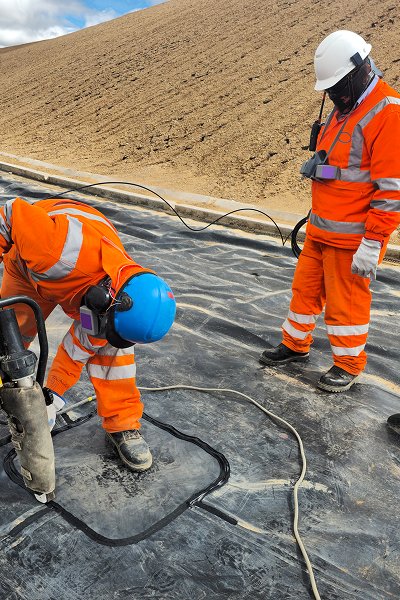Glass fiber as a reinforcing skeleton material has extremely high tensile modulus and strength. The geogrid made of it is not easy to elongate, aging-resistant and corrosion-resistant, and is suitable for engineering projects with high requirements for stability and durability.


Raw materials: alkali-free glass fiber
The yarn used in glass fiber geogrid is alkali-free glass fiber, which has the following characteristics:
High tensile modulus (>70GPa);
Excellent corrosion resistance;
High temperature resistance, can maintain stable performance in the range of -40℃ to 260℃;
Good chemical stability, no reaction with soil, asphalt, cement, etc.
Product performance characteristics
Extremely high tensile strength; glass fiber itself has excellent tensile strength. After being made into a grid, its tensile strength in the longitudinal and transverse directions often reaches 50-200kN/m, which is far higher than ordinary plastic geogrids. It can effectively share the stress of the pavement structure and delay the appearance of reflective cracks.
Stable structural stiffness; low elongation (generally <3%) means that it hardly undergoes permanent deformation under load, which is conducive to controlling pavement deformation and improving structural stiffness, especially suitable for soft foundation reinforcement.
Excellent high temperature resistance and aging resistance; glass fiber itself does not melt or burn, and its thermal stability is far better than that of polypropylene and polyester grids. It is safer and more reliable to construct in high temperature areas, heavy-loaded roads or high-temperature mixed asphalt mixtures.
Strong corrosion resistance; after the surface is coated with modified asphalt or PVC coating, the glass fiber grid can resist the erosion of chemical substances such as acid, alkali, salt, and oil, and has stronger durability in saline-alkali land, seaside, and rainy areas.
Product classification
Unidirectional fiberglass grating: mainly bears tension in one direction, used for unidirectional reinforcement needs;
Bidirectional fiberglass grating: balanced load-bearing in the longitudinal and transverse directions, often used for roadbed paving and road reinforcement;
Coated fiberglass grating: the surface is coated with special materials to enhance the adhesion with asphalt mixture;
Composite fiberglass grating: such as composite with geotextile or non-woven fabric, used to take into account both drainage and reinforcement functions.
After-sales guarantee: Establish the basis for long-term cooperation
Provide a warranty period commitment (usually 3 to 5 years);
Issue a complete test report and batch label for easy acceptance;
For problems that arise during use, whether to provide technical support and material replacement;
Whether to sign a long-term framework agreement and provide a price protection strategy.
Some high-quality suppliers will also regularly visit the project usage to help customers optimize construction results and improve material utilization.
Choosing a reliable fiberglass geogrid supplier is not a price war. From corporate qualifications, production strength, technical support to market reputation, delivery capabilities, and after-sales service, every detail may affect the stable operation and final cost of the entire project.
For construction units and project parties, it is recommended to give priority to brand suppliers with integrated R&D, production, and service capabilities to establish long-term cooperative relationships, which will not only help ensure the quality of the project, but also give play to the synergistic advantages in project management and construction period control.


